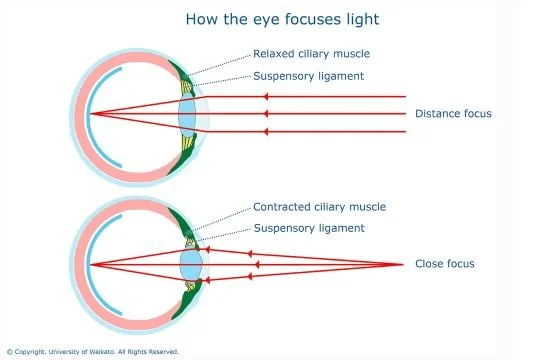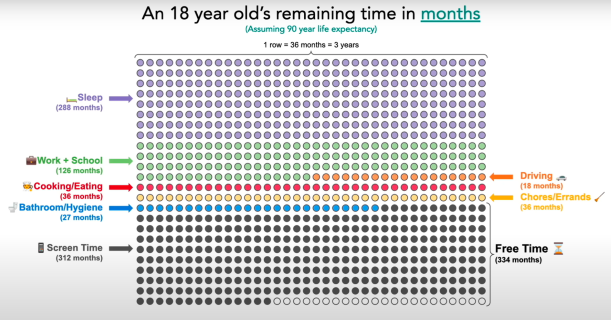Issue #461: How to Protect Your Eyes
Good morning. It’s Tuesday, July 8th.
Our hearts are with everyone in Central Texas facing the devastating floods. We hope you and your loved ones are safe, and we’re sending strength to all those affected. At Thrive25, we believe in the power of community, and we stand with you during this challenging time.
Consider donating to World Central Kitchen or other local organizations.
In today’s email:
Learn: Protect Your Vision
Try: Relax Your Eyes
Think: How Much Do You Pay?
In the News: The Powers of Super Seeds
Stat of the Day
Rate of near-sightedness (myopia) in the U.S. This is a 66% increase over the last 30 years. (National Institute of Health)
Learn
Protect Your Vision
A few days ago, I took my 4-year-old son to his pediatric wellness checkup. Like all kids - he had to complete the classic vision test - reading letters down a hallway on a Snellen chart, 20 feet away.
So I figured I should test my eyesight too.
I’ve made it to 44 without glasses, contacts, or LASIK. Happy to report that I could read down to the second-to-last row of tiny letters - which means I have 20/15 vision.
I also wondered what 20/20 really meant. Here’s how to make sense of this scale:
20/20 means you can see at 20 feet what the average person sees at 20 feet - basically this is what we’re aiming for.
20/15 means you can see at 20 feet what most people need to be at 15 feet to see. Better than average.
But 20/40? You can only see at 20 feet what others can see clearly from 40 feet away - and that’s what happens for most people as we age and need glasses or contacts.
It got me thinking - why are more people - especially kids - developing myopia?
📉 Why Our Eyes Are Struggling
It’s the same reason as everything else with our health - our modern world isn’t built for eye health:
Too much indoor time - artificial light lacks the full spectrum of sunlight that our eyes evolved to depend on.
Poor metabolic health - blood flow and mitochondrial function matter for your eyes, too.
Nutrient deficiencies - especially in Vitamin A, omega-3s, and antioxidants.
Near-work overload - constant close-up focus (screens, reading, phones) keeps our lenses in a contracted state and fatigues the muscles that control them.
When you’re focused on something close, the ciliary muscles in your eyes tighten and your lens thickens to adjust. Do this all day long, and those muscles never get to relax.
But when you look out into the distance, your lens flattens, your muscles release, and your whole system calms down.
But I don’t need to prove the science here - all of us can feel ourselves relax as soon as we get outside or look off into the distance. That’s our eyes returning to their default setting.
🌄 Montana Showed Me the Power of the Horizon
We’ve been in Montana the last few days, and my eyes have never felt more relaxed. Out here, it’s almost impossible not to gaze far into the distance. It’s a form of rest we don’t often get indoors - and it’s medicine for our overstimulated visual systems.
Glacier National Park (Jul 7th)
Even if you’re not in Glacier National Park, you can still give your eyes that same reset.
🧘♂️ Try a “soft gaze” - a term borrowed from yogic traditions - by looking out a window, or at the horizon, without focusing on anything in particular. Try to not only relax your eyes, but also your face and jaw. Doing this a few times a day as a break from our screens is huge to maintain focus and not get mentally exhausted.
☀️ Why Kids Need Sunlight
It’s not just looking off into the distance - it’s also getting the full spectrum of sunlight.
Kids who spend more time outdoors have lower rates of myopia - even if they still use screens.
Dr. Jeff Goldberg (ophthalmologist at Stanford) told Dr. Andrew Huberman that lack of outdoor light may be a bigger driver of worsening eyesight in kids than screen time itself.
Natural sunlight provides the full spectrum of light our eyes need to develop properly - especially the blue-green wavelengths that help regulate eye growth and retinal development.
💪 What Else Can You Do for Your Eyes?
🏃♂️ Exercise
Not surprisingly (it’s a medicine for everything) - regular movement increases blood flow and delivers oxygen and nutrients to your retina and optic nerve.
Zone 2 cardio (like walking at a fast pace or cycling) is especially helpful for blood flow
Strength training helps regulate blood pressure - this is critical for preventing eye diseases like glaucoma and cataracts
🥕 Vitamin A
Yes, carrots really do help your vision. Vitamin A is essential for:
Building rhodopsin, the protein that allows your retina to see in low light
Protecting the cornea from drying and damage
Here are the top sources of Vitamin A:
🧬 Astaxanthin
Dr. Huberman highlights astaxanthin as a powerful antioxidant that protects against age-related macular degeneration (AMD) and retinal inflammation.
Found naturally in wild salmon and shrimp
You can also supplement it - look for natural forms sourced from algae
Try
Relax Your Eyes
If your eyes feel strained, tired, or “off,” it’s not just aging.
It’s your modern lifestyle overloading your visual system.
To protect your eyes - and your energy:
Spend more time outside - ideally 1+ hour a day
Look up and out throughout your day - 5+ times a day
Feed your body the nutrients it needs to support your vision - eat orange foods
Move your body to support circulation and energize your mitochondria
We take our vision for granted until we don’t have it. Yet it’s key to independence and experiencing life fully.
So don’t just think about what you’re seeing today - think about what you want to see 25+ years from now.
Thrive25 Partner Spotlight
You invest for retirement - but what about your health?
Thrive25 gives you a Personal Longevity Advisor in your pocket to build a plan that fits your life.
With one secure health hub you can organize everything from lab results to doctor notes. Get a personalized blueprint to help you move better, think clearer, and stay independent for decades to come.
This is the tool we built for ourselves - because we wanted a smarter, simpler way to feel great today and stay active with our families tomorrow.
Start your own journey now with $6.99/month (or $50/year) early access pricing. Click HERE to take control of your health today!
Think
How Much Do You Pay?
It’s not until we step away from our screens that we see what we’ve been missing.
The following visual really struck me. We are all different - but technology is quietly taking over our lives.
Most of us wouldn’t pay $20 for a monthly social media (or really any) subscription. BUT…what is our time actually worth?? It’s a different perspective when you think about the hours on a screen.
Consider this: if you live from 18 to 90, you have roughly 334 months of “free time.” How much of that precious time do you want to spend glued to a screen?
Even if we spend a fraction of our time online, the reality is sobering: many kids today are on track to spend up to 93% of their free time staring at screens!
Our time is priceless. We can’t truly measure its value, but we can choose to spend it on what matters most - things that bring energy, purpose, fulfillment, love and gratitude.
Make that choice now. Before you lose any more time.
H&L in the News
Sprinkle Super Seeds Daily: Chia, flax, and hemp seeds pack fiber, protein, and omega-3s into every spoonful. Boost heart, brain, and gut health effortlessly by adding these versatile super seeds to meals and snacks. (Washington Post)
Rewiring the Brain with Roots: Ibogaine, a powerful African psychedelic, may help reverse brain injury and PTSD. Stanford’s early research shows dramatic results - despite safety risks and a long road to U.S. approval. (Big Think)
When Continents Collide (and Creep): Eastern North America isn’t as sleepy as it looks. From ancient collisions to surprise volcanoes, its wild geologic past is reshaping what we know about how continents are built. (Knowable)
Thanks for joining us today!
Want to see what we’re up to? Sign up for early access to our platform
Check out the latest videos on our YouTube channel
Got feedback, recommendations or stories to share? Tell us what’s on your mind here
Want this direct to your inbox? Sign up here
Why Thrive25
We’re 40-something dads that felt our bodies and minds start to slow down and we’re not ready for that. We found too much information on every subject. So we started Thrive25 to transform what we’ve learned into something useful for the rest of us to spend just 3-5 min a day to optimize our health & longevity.
This newsletter is for you and we truly value your feedback. Never hesitate to reach out to us at team@thrive25.com.
To health!
Sign up for free:
The information in this newsletter is for informational purposes only and may not be appropriate or applicable based on your individual circumstances. Thrive25, Inc. does not provide medical, professional, or licensed advice. Please connect with your healthcare professional for medical advice specific to your health needs.










